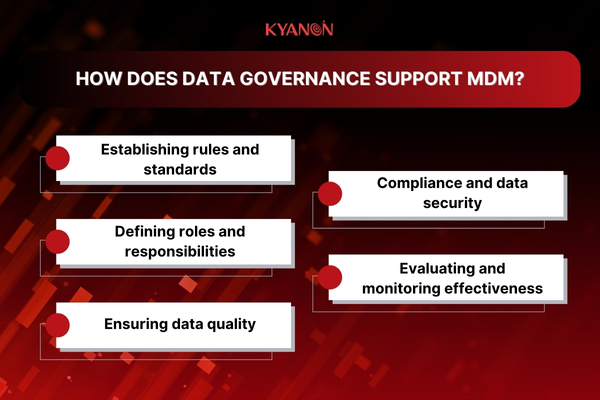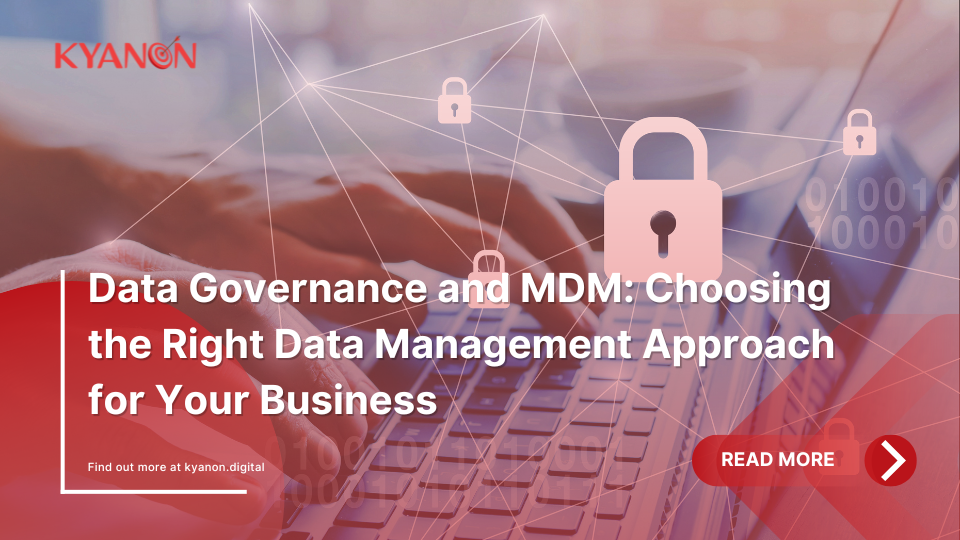Effective data management is a key factor in a business’s success in today’s digital age. Data Governance and Master Data Management (MDM) are two critical components that help businesses organize and optimize their data. Although closely related, each plays a different role.
This article clarifies the differences between Data Governance and MDM and provides guidance on how to apply them to enhance data management within your business.

1. What’s the difference between Data Governance and MDM?
While both Data Governance and MDM are involved in managing data within a business, they serve different purposes and functions.
Feature | Data Governance | MDM |
| Definition | A set of processes, policies, and tools to ensure data quality, integrity, and security throughout the organization. | The process of managing, updating, and synchronizing the main data in the master data. |
| Goal | Build a unified framework, ensure efficient, accurate use of data, and optimize decision-making. | Eliminate data duplication and inconsistencies, create a reliable data source, and improve report quality. |
| Scope | The entire lifecycle and all types of data. | Mainly master data objects (customers, products, employees, etc.). |
| Key activities | Develop policies, grant permissions, monitor, evaluate data quality, and handle security issues. | Identify master data objects, build an MDM system, and integrate, cleanse, and standardize data. |
| Relationship | MDM is both a part of Data Governance and helps achieve Data Governance goals. | Data Governance provides a framework and policies for MDM. |
| Example | Setting a rule that customer data must be updated within 24 hours. | Merging customer data from multiple systems into a single record. |
In summary, Data Governance sets the rules and policies for managing data across the organization, while MDM focuses on organizing and maintaining high-quality master data that adheres to those rules. Both are essential to building a comprehensive data management strategy.
2. How does Data Governance support MDM?
Despite their differences, Data Governance provides the ideal environment for MDM to function effectively.
- Establishing rules and standards: Data Governance provides clear rules and standards for how master data should be managed, including defining consistency, accuracy, and data lineage. This ensures MDM operates within a clearly defined framework, with all data processing procedures adhering to pre-set set rules.
- Defining roles and responsibilities: A good data governance system clearly defines who is responsible for the data, from oversight to maintenance and management. Clear assignment of roles and responsibilities across departments makes the MDM process easier to implement, ensuring master data is effectively managed.
- Ensuring data quality: Data Governance is responsible for establishing policies and procedures to maintain and improve data quality. Applied to MDM, this ensures that master data is highly reliable and consistent across systems with minimal errors.
- Compliance and data security: Another capability of Data Governance is to monitor regulatory compliance and data security policies. As a result, MDM always complies with legal and security requirements, ensuring that master data is accurate and secure.
- Evaluating and monitoring effectiveness: Data Governance provides tools to track and assess the effectiveness of data management processes, including MDM. Through continuous evaluation, businesses can promptly identify and improve weaknesses in master data management.
Thus, Data Governance lays the foundation and provides the tools and processes for MDM to function effectively, ensuring that a business’s master data is accurate, consistent, and compliant with standards and regulations.

3. 7 Tips to Improve Data Governance and Enhance MDM Effectiveness
3.1. Building a Data Governance Framework
Initially, businesses need to clearly define the roles and responsibilities of each person involved, from data managers to data analysts. Developing a comprehensive governance framework that includes policies, processes, and standards will help businesses manage data assets, ensuring consistency and compliance with regulations.
3.2. Prioritizing Master Data
Next, businesses should categorize master data types that play a crucial role in operations, such as customer information, product details, and employee information. Assessing the quality and consistency of this data and building a master data management strategy is key to improving data quality and ensuring data integrity.
3.3. Implementing Data Quality Management
Regularly monitor, evaluate, and improve data quality by identifying key indicators, detecting errors, and addressing issues through continuous audits. This process not only ensures data reliability but also helps reduce risks in decision-making.
3.4. Ensuring Data Security and Privacy Compliance
Ensure that your MDM system complies with data protection regulations (like GDPR and CCPA) by implementing security and privacy measures to protect customer information. This helps businesses avoid legal risks and builds trust with customers, especially as users are becoming more concerned about personal data privacy and security.
3.5. Fostering Collaboration Between Departments
When business units, IT departments, and data governance teams work closely together, master data is properly aligned with goals and effectively utilized. This reduces data fragmentation and improves decision-making quality.
3.6. Leveraging Data Management Technology
Businesses can consider using data governance tools to automate tasks and improve efficiency. Implementing metadata management capabilities will allow businesses to easily track the origin and flow of data.
3.7. Continuously Training Employees
Investing in data management personnel enhances the quality of work and builds a loyal, dedicated, and responsible workforce.

4. Data Governance and MDM Enhance Business Agility
Data Governance and MDM are crucial in maintaining and improving a business’s competitiveness in an increasingly volatile and unpredictable business environment. According to the Gartner report, businesses with effective data governance can reduce data-related risks by up to 40% and improve performance by up to 30%.
By ensuring critical information is standardized and consistent, businesses can quickly respond to market fluctuations, thus enhancing agility and optimizing performance. The combination of Data Governance and MDM helps maintain organizational stability and expands the ability to seize new opportunities, quickly respond to market demands, and adjust strategies in a timely manner.
To succeed in the digital era, businesses must fully leverage the value of data by effectively applying Data Governance and MDM. Understanding the differences and applying these two elements correctly will help businesses build a solid data foundation and support strategic decisions accurately. This provides a sustainable competitive advantage, contributing to long-term growth and success.
If your business is facing challenges with data management, contact Kyanon Digital. Our data experts at Kyanon Digital will help you build a secure, unified, and effortlessly manageable data system.


